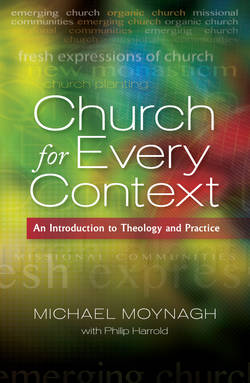Читать книгу Church for Every Context - Michael Moynagh - Страница 91
На сайте Литреса книга снята с продажи.
Secularization
ОглавлениеThis decline has often been understood in terms of secularization – a slippery term that has been used in different ways. Writers on secularization tend to refer to the decline of religion, which is not exactly the same as the decline of church. The assumption here is that a loss of influence by the Christian religion will be reflected in falling attendance at church. Secularization is taken as referring to the decline in church attendance and influence.
The sociologist, Bryan Wilson, defined secularization ‘as the process by which religious thinking, practices, and institutions lose their significance for the operating of the social system’. He added that religion is not destined to disappear entirely: rather, its presence and significance in society will diminish as economies industrialize and become increasingly advanced (Wilson, 1998, p. 49).
Steve Bruce (2002) highlights the rise of rationality and individualism as integral to the process of secularization. Rationality was reflected in the spread of scientific modes of thought, which removed the need for religion to explain the world, made many religious ideas and doctrines implausible and, in particular, created a sense of mastery over fate. Embodying rational procedures within bureaucratic organizations created an impression that order in the world could be maintained without the aid of God.
Individualism has undermined the communal basis of religious life. When, thankfully, society became tolerant of non-Christian beliefs, these beliefs mushroomed and then challenged existing views. It is harder to be confident in an opinion when it is assailed by alternatives. The multiplication of views makes opinions about faith increasingly subjective – religious views become a matter of personal choice. Religion has shrunk from being accepted by the bulk of society to being one lifestyle option among many. The decline is likely to continue.
The inevitability of secularization has been disputed by scholars who note that religious affiliation worldwide is rising (see Davie, 2007, pp. 64–5, 104–9). As the global south has industrialized, the number of religious adherents has not shrunk, as the secularization thesis predicts, but grown – witness, for example, the expansion of the African churches. This is often seen as a knock-down argument against secularization.
However, drawing on four waves of the World Values Survey conducted between 1981 and 2001 and extending to nearly 80 countries, Norris and Inglehart (2004) argue that societies do indeed become increasingly secular as economies develop. More people overall may adhere to traditional religion (including Christianity), but this is because the effects of modernization have not yet become fully apparent.
Besides leading to a decline in religion, modernization also reduces the fertility rate. Better education is associated with smaller families. When birth rates drop in secularizing countries, younger more secular cohorts are smaller than older traditional ones, among whom religious practice is more widespread. The overall decline in religion appears less marked. On the other hand, in countries where modernization is occurring more slowly, higher birth rates produce relatively large cohorts of more religiously committed young people. These two trends together disguise the long-term trend for religion to become less significant.
Shorter and Onyancha (1997) found that 40 per cent of people attended church weekly in traditional rural Kenya, but only 12 per cent did so in the modernizing capital of Nairobi (with 20 per cent attending less frequently). Though church attendance in Nairobi increased as the city’s population grew, observers exaggerated the trend because church building did not keep pace with the growing number of worshippers: churches were full to overflowing. It looked as if the churches were flourishing. In reality, church attendance was falling in percentage terms because the urban population was expanding even faster than church numbers. If attendance was measured as a proportion of the population, the church was losing ground. Nairobi illustrates how the global South appears to be following the secularizing trends of the global North.
Both Shmuel Eisenstadt (2000) and Bruce (2001) have warned against assuming that other countries will tread exactly Europe’s path of modernization. In Eisenstadt’s phrase, there are ‘multiple modernities’, each shaped by the history and culture of the country concerned. Proponents of secularization can argue, therefore, that secularization will look different and occur at a different pace from one part of the world to another.
